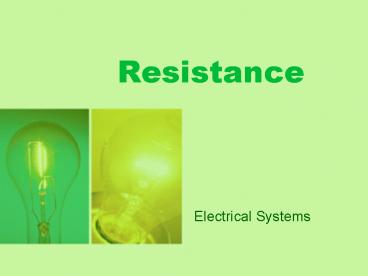Resistance PowerPoint PPT Presentation
1 / 22
Title: Resistance
1
Resistance
- Electrical Systems
2
Electrical Resistance
- Opposition to the flow of electrons
- Collisions between electrons and atoms
- Electrons drift velocity is very low because of
all the collisions
3
Resistivity
- When we studied fluid resistance we learned that
a longer thinner pipe had more resistance to
fluid flow - The resistance of a wire is affected by
- Length of wire (longer wiregreater resistance)
- Diameter of wire (smaller diameter greater
resistance) - Wire material
- R ? (L/A)
4
Resistivity of Materials
5
Resistance in a Circuit
- Resistance is calculated using Ohms law
- The potential difference (voltage) across an
ideal conductor is proportional to the current
through it. - The constant of proportionality is called the
resistance, R - Ohm's Law is given by
- V I R
- Units for Resistance
- Ohms (?)
- Equal to 1 Volt/Amp
6
Ohms Law
- An electrical device with a resistance of 100 ?
has a current of 30 mA flowing through it. What
is the potential difference of the voltage
source? - V IR
- V (3 mA) x (100 ?)
- V (0.030 A) x (100 ?)
- V 3 V
7
Ohms Law
- When connected to a 120-V source, an electric
heater will allow 10 Amps of current to flow.
What is the resistance of the heater? - V IR
- R V / I
- R 120 V / 10 A 12 ?
8
Schematic Diagrams
- Symbols for circuit elements
9
Resistors in Series
- Only one path for charge to take
- Current is the same in each
- One resistor burns out, it opens the circuit and
charge can no longer flow - All the lights go out (
10
Potential Drop in Series
- As a charge goes through a resistor, its
potential (voltage) drops - The charges leave the battery with potential that
drops through each resistor depending on the
resistance - Potential drops to zero when it reaches the
opposite terminal
11
Equivalent Resistance Series
- One resistor that could replace all the resistors
in the circuit - REq is always larger than the biggest resistor
- As each charge has to go through each resistor in
series, the total resistance is found by adding
them all up. - REq R1 R2 R3 ...
12
Example Problem Series
- Find the equivalent resistance
- Use Ohms Law to find the total current
- Current is the same in all resistors
- Find the voltage drop across each one using Ohms
Law
13
Resistors in Parallel
- Each resistor added in parallel provides
another path for current to flow - If one light burns out, the rest can stay on
because all the other lights still have a
complete loop connected to the battery
14
Potential Drop in Parallel
- Because each resistor is connected to the
battery, the voltage across each one is the same - The voltage across each resistor is equal to the
potential difference of the battery
15
Equivalent Resistance Parallel
- When more paths are added, resistance goes down
- REq is always less than the smallest resistor!
16
Equivalent Resistance Parallel
- If the resistors are equal, two resistors will
cause half as much resistance and 3 resistors
will cause one-third as much resistance - Instead of adding
- 1/REq 1/R1 1/R2 1/R3
17
Example Problem Parallel
- Find the equivalent resistance
- Find the total current using Ohms Law
- The voltage is the same for all resistors
- Find the current in each resistor using Ohms Law
18
Combination Circuits
- Circuits can sometimes be a combination of both
series and parallel resistors - Find the equivalent resistance for the parallel
resistors - Add this to the series resistors
19
Example Problem Combination Circuit
- Find the resistance in the following circuit
- Parallel 1/REq (1/6?) (1/6?) 2/6?
- REq 6 ? /2 3 ?
- Series REq 3 ? 3 ? 5 ? 11 ?
20
Series vs. Parallel
- Resistors are like toll booths on a highway
21
Series vs. Parallel
- Series Circuits
- The current is the same in every resistor this
current is equal to that from the battery. - IT I1 I2 I3
- The sum of the voltage drops across each resistor
is equal to the voltage of the battery. - VT V1 V2 V3
- The equivalent resistance of the collection of
resistors is greater than any one resistor and is
found by the equation - REq R1 R2 R3 ...
- Parallel Circuits
- The voltage drop is the same across each parallel
branch and is equal to that in the battery. - VT V1 V2 V3
- The sum of the current in each individual branch
is equal to the total current from the battery. - IT I1 I2 I3
- The equivalent resistance of the collection of
resistors is smaller than any one resistor and is
found by the equation - 1/REq 1/R1 1/R2 1/R3 ...
22
Applications of Electrical Resistance
- When you need control the flow of current
- Control the amount of electrical energy used by a
device - Convert electrical energy into heat, light,
sound, motion, and information - Clipart http//www.physicsclassroom.com/

